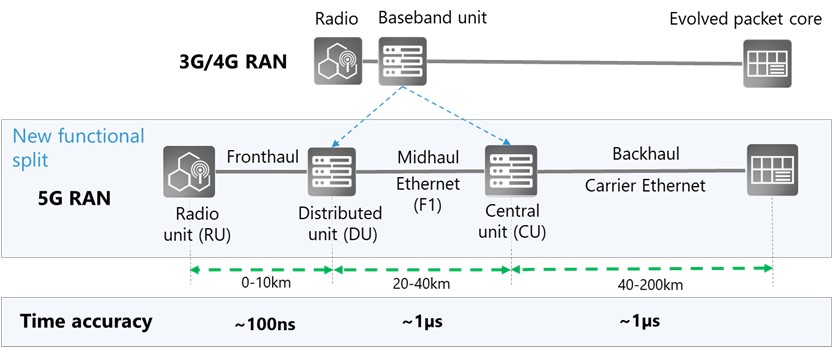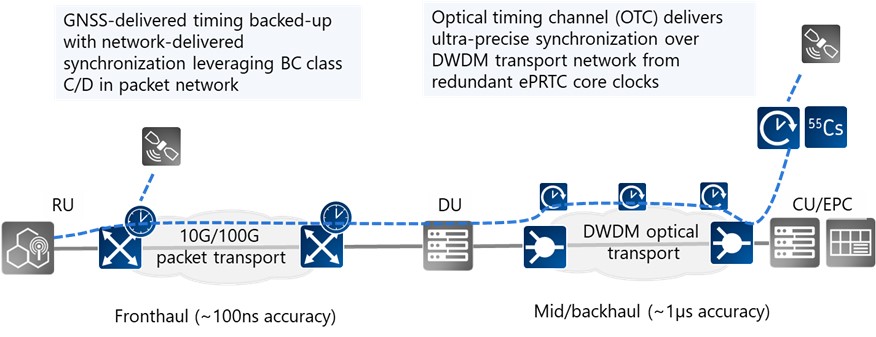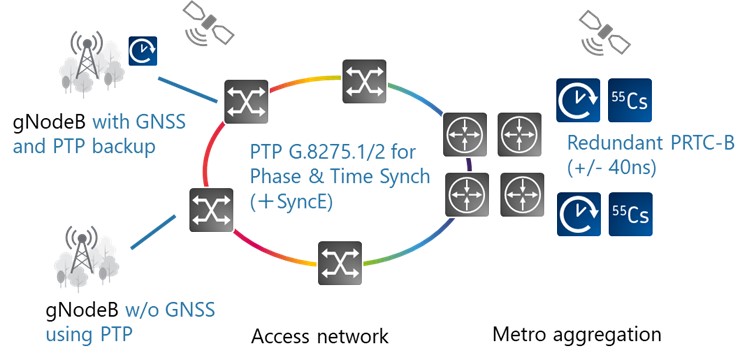Brazil
Breadcrumb navigation
July 15, 2022


Maximizing the value of 5G transport networks with precise timing


Maximizing the value of 5G transport networks with precise timing

Ulrich Kohn
Director Solutions Marketing
ADVA

Mihoko Mori
Global Telecom Marketing Manager
NEC Corporation
Why timing is so crucial for next-generation mobile services
With 5G, mobile network services can address whole new applications, extending service offering for mobile users to connectivity for IoT and industrial devices. 5G networks enable enterprises to seamlessly integrate a wide range of fixed and portable network components such as cameras, sensors, valves, relays or other intelligent devices into their industrial monitoring and control processes. Tight synchronization of distributed processes is a pre-requisite to efficiently use 5G services. Rolling out 5G without improving the synchronization network will fail to meet business expectations.
And then there’s the mobile network itself. This too requires more accurate synchronization to deliver new levels of spectral efficiency and aggregated bandwidth. With 5G, advanced radio access technologies are applied to achieve higher capacity, lower latency and better utilization of the radio spectrum. Carrier aggregation within a frequency band and intra-band carrier aggregation combine radio spectrum for high-bandwidth services. Such higher efficiency calls for stringent timing accuracy. While LTE eICIC requires several µs, inter-site carrier aggregation and coordinated multi-point transmission in 5G pushes the limits of time accuracy below a value of 1µs, towards several hundred ns. What’s more, the architectural evolution from 4G to 5G provides new opportunities to disaggregate base stations into a radio unit (RU), distributed unit (DU) and central unit (CU). Time accuracy requirements are most stringent at the interface between the DU and RU.

What options do we have for improving synchronization accuracy?
Time and frequency synchronization can be delivered to a network device such as a radio base station, a DU or RU in different ways:
- Precision Time Protocol (PTP) delivers synchronization by transporting timestamped packets over an IP or Ethernet network. Any intermediate node negatively impacts synchronization quality. Alternatively, timing packets can be transported over dedicated bidirectional optical links, bypassing any intermediate switch for nanosecond-level accuracy. ADVA’s optical timing channel technology has been developed specifically for very precise delivery of synchronization over dedicated optical wavelengths.
- GNSS constellations – such as the USA’s GPS, European Galileo or Chinese Beidou – provide highly precise timing from the sky. Those system can however easily be jammed and spoofed. This is why they should not be used as a sole source of timing.
- Clocks built on cesium atomic technology can provide ultra-stable and precise frequency information. In combination with GNSS receivers and clock combiners, enhanced primary reference time clock (ePRTC) configurations can also hold this time over extended periods of GNSS unavailability.
Now let’s explore how these different methods can be combined in a timing architecture that creates synergies and leverages the advantages of each technology while mitigating its weaknesses.
What’s the most effective way to combine synchronization technologies?
Historically, synchronization has been delivered from the core of a network to the edge. Very stable clocks – in most cases using cesium atomic technology – are locked to UTC time with GNSS receivers in colocated grandmasters. Time and frequency information is delivered over the packet network by my means of SyncE and PTP. Accuracy of synchronization, however, degrades as the signal proceeds through a packet network from the core to the edge.
With 5G networks, we are facing a very challenging situation as the required timing accuracy at the fronthaul network is higher than in the backhaul and mobile core. What’s more, the accuracy requirements are also more stringent than most currently installed packet networks in the core and in the radio access network can deliver. New approaches are needed.
Optical timing channel technology in core networks bypasses the routers and switches. PTP and SyncE are delivered natively over a dedicated optical wavelength to high-performance synchronization devices with sophisticated boundary clock functionality. By decoupling the synchronization network from the data path, the degradation in the core packet network can be avoided, and a highly accurate timing signal can be delivered over the dedicated optical timing channel to the radio access network.
In the fronthaul network, grandmasters constantly monitor the incoming synchronization signal and compare it with satellite-delivered time. In case of any disturbance, GNSS-delivered synchronization can be used as a backup. As long as the high-performance optical timing channel in the core network is not available, edge grandmasters can initially deliver accurate synchronization in the radio access network from their integrated GNSS receivers.

NEC's competence in system integration meets ADVA's excellence in timing solutions
As outlined above, different strategies can be applied for making synchronization networks ready for 5G. A mobile network operator might initially install compact grandmasters in the radio access network to secure ultra-precise synchronization from the sky. In a second step, the core network can be complemented by a dedicated optical timing channel for delivery of precise synchronization from redundant core clocks. Some mobile network operators start from the core and upgrade with core clocks for higher stability and accuracy and improve the accuracy of synchronization delivery in the next step. Therefore, for each operator to select and implement the right time synchronization solution that matches its strategy, it is essential to have the right partner and flexible solution.
NEC is a global provider of open network technology and has the rich experience of system integration services across the globe. The company has successfully migrated many operators towards the latest mobile technologies with robust transport network solutions. This experience accumulated in its Centers of Excellence is the backbone of strong global consulting and engineering services including time synchronization. As part of NEC open 5G xHaul ecosystem, ADVA provides scalable, precise and flexible  timing solutions, enabling network upgrades to meet the most stringent timing requirements, crucial for the introduction of 5G services.
timing solutions, enabling network upgrades to meet the most stringent timing requirements, crucial for the introduction of 5G services.
A recent NEC and ADVA customer case with a global operator involved is combining innovative timing technologies with multiple synchronization sources for highly precise and very robust timing of their gNodeBs. The latest GNSS receiver technology was applied for accurate satellite-delivered timing. To mitigate any GNSS problem, resilient PRTC-B core clocks are being used to deliver timing over a SyncE/PTP-aware transport network as a backup. This resilient and pragmatic synchronization architecture has enabled the operator to introduce the latest 4G/5G TDD technology, enabling a wide portfolio of attractive new mobile services.

The experience of NEC in evolving synchronization networks in combination with the comprehensive solution portfolio of ADVA’s Oscilloquartz division enables mobile network operators to deploy the timing architecture they require to secure the success of their 5G service innovation.